Filters: Collection:"ir_uspace"
| Creator | Title | Description | Subject | Date | ||
|---|---|---|---|---|---|---|
| 126 |  | Herbert, John; Myntti, Jeremy; Witkowski, Alan; Alexander, John | Getting the Crowd into Obituaries: How a Unique Partnership Combined the World's Largest Obituary Index with the Utah's Largest Historic Newspaper Database | Presentation given at the IFLA International Newspaper Conference, Salt Lake City, UT. | Newspapers; Crowdsourcing | 2014-02-04 |
| 127 | 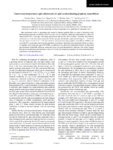 | Liu, Feng | Giant room-temperature spin caloritronics in spin-semiconducting graphene nanoribbons | Spin caloritronics refers to generating spin current by thermal gradient. Here we report a theoretical study demonstrating giant spin caloritronic effects in a new class of materials, called spin semiconductors, which are characterized with a "spin gap," the energy gap between spin-up and -down chan... | 2014-01-01 | |
| 128 |  | Kirby, Robert Michael | GPU-based volume visualization from high-order finite element fields | This paper describes a new volume rendering system for spectral/hp finite-element methods that has as its goal to be both accurate and interactive. Even though high-order finite element methods are commonly used by scientists and engineers, there are few visualization methods designed to display thi... | 2014-01-01 | |
| 129 | 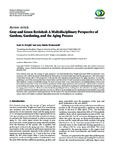 | Wright, Scott D. | Gray and green revisited: a multidisciplinary perspective of gardens, gardening, and the aging process | Over fourteen years ago, the concept of "gray and green" was first introduced by Wright and Lund (2000) to represent a new awareness and a call for increased scholarship at the intersection of environmental issues and the aging process. This review paper revisits that concept with a fresh perspectiv... | 2014-01-01 | |
| 130 | 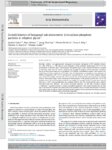 | Ring, Terry Arthur | Growth kinetics of hexagonal sub-micrometric β-tricalcium phosphate particles in ethylene glycol | Recently, uniform, non-agglomerated, hexagonal b-tricalcium phosphate (b-TCP) platelets (diameter 400-1700 nm, h 100-200 nm) were obtained at fairly moderate temperatures (90-170 C) by precipitation in ethylene glycol. Unfortunately, the platelet aspect ratios (diameter/thickness) obtained in the ... | 2014-01-01 | |
| 131 | 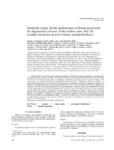 | Dailey, Andrew T. | Guideline update for the performance of fusion procedures for degenerative disease of the lumbar spine. Part 10: Lumbar fusion for stenosis without spondylolisthesis | Lumbar stenosis is one of the more common radiographic manifestations of the aging process, leading to narrowing of the spinal canal and foramen. When stenosis is clinically relevant, patients often describe activity-related low-back or lower-extremity pain, known as neurogenic claudication. For tho... | 2014-01-01 | |
| 132 | 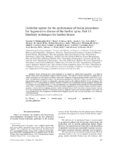 | Dailey, Andrew T. | Guideline update for the performance of fusion procedures for degenerative disease of the lumbar spine. Part 11: Interbody techniques for lumbar fusion | Interbody fusion techniques have been promoted as an adjunct to lumbar fusion procedures in an effort to enhance fusion rates and potentially improve clinical outcome. The medical evidence continues to suggest that interbody techniques are associated with higher fusion rates compared with posterolat... | 2014-01-01 | |
| 133 | 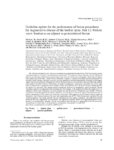 | Dailey, Andrew T. | Guideline update for the performance of fusion procedures for degenerative disease of the lumbar spine. Part 12: Pedicle screw fixation as an adjunct to posterolateral fusion | The utilization of pedicle screw fixation as an adjunct to posterolateral lumbar fusion (PLF) has become routine, but demonstration of a definitive benefit remains problematic. The medical evidence indicates that the addition of pedicle screw fixation to PLF increases fusion rates when assessed with... | 2014-01-01 | |
| 134 | 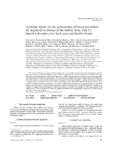 | Dailey, Andrew T. | Guideline update for the performance of fusion procedures for degenerative disease of the lumbar spine. Part 13: Injection therapies, low-back pain, and lumbar fusion | The medical literature continues to fail to support the use of lumbar epidural injections for long-term relief of chronic back pain without radiculopathy. There is limited support for the use of lumbar epidural injections for short-term relief in selected patients with chronic back pain. Lumbar intr... | 2014-01-01 | |
| 135 | 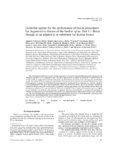 | Dailey, Andrew T. | Guideline update for the performance of fusion procedures for degenerative disease of the lumbar spine. Part 14: Brace therapy as an adjunct to or substitute for lumbar fusion | The utilization of orthotic devices for lumbar degenerative disease has been justified from both a prognostic and therapeutic perspective. As a prognostic tool, bracing is applied prior to surgery to determine if immobilization of the spine leads to symptomatic relief and thus justify the performanc... | 2014-01-01 | |
| 136 | 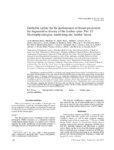 | Dailey, Andrew T. | Guideline update for the performance of fusion procedures for degenerative disease of the lumbar spine. Part 15: Electrophysiological monitoring and lumbar fusion | Intraoperative monitoring (IOM) is commonly used during lumbar fusion surgery for the prevention of nerve root injury. Justification for its use stems from the belief that IOM can prevent nerve root injury during the placement of pedicle screws. A thorough literature review was conducted to determin... | 2014-01-01 | |
| 137 | 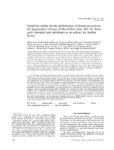 | Dailey, Andrew T. | Guideline update for the performance of fusion procedures for degenerative disease of the lumbar spine. Part 16: Bone graft extenders and substitutes as an adjunct for lumbar fusion | In an attempt to enhance the potential to achieve a solid arthrodesis and avoid the morbidity of harvesting autologous iliac crest bone (AICB) for a lumbar fusion, numerous alternatives have been investigated. The use of these fusion adjuncts has become routine despite a lack of convincing evidence ... | 2014-01-01 | |
| 138 | 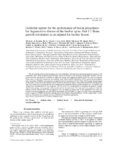 | Dailey, Andrew T. | Guideline update for the performance of fusion procedures for degenerative disease of the lumbar spine. Part 17: Bone growth stimulators as an adjunct for lumbar fusion | The relationship between the formation of a solid arthrodesis and electrical and electromagnetic energy is well established; most of the information on the topic, however, pertains to the healing of long bone fractures. The use of both invasive and noninvasive means to supply this energy and supplem... | 2014-01-01 | |
| 139 | 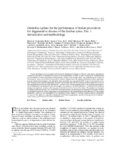 | Dailey, Andrew T. | Guideline update for the performance of fusion procedures for degenerative disease of the lumbar spine. Part 1: Introduction and methodology | Fusion procedures are an accepted and successful management strategy to alleviate pain and/or neurological symptoms associated with degenerative disease of the lumbar spine. In 2005, the first version of the "Guidelines for the performance of fusion procedures for degenerative disease of the lumbar ... | 2014-01-01 | |
| 140 | 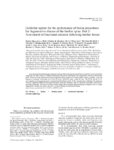 | Dailey, Andrew T. | Guideline update for the performance of fusion procedures for degenerative disease of the lumbar spine. Part 2: Assessment of functional outcome following lumbar fusion | Assessment of functional patient-reported outcome following lumbar spinal fusion continues to be essential for comparing the effectiveness of different treatments for patients presenting with degenerative disease of the lumbar spine. When assessing functional outcome in patients being treated with l... | 2014-01-01 | |
| 141 | 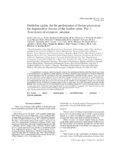 | Dailey, Andrew T. | Guideline update for the performance of fusion procedures for degenerative disease of the lumbar spine. Part 3: Assessment of economic outcome | A comprehensive economic analysis generally involves the calculation of indirect and direct health costs from a societal perspective as opposed to simply reporting costs from a hospital or payer perspective. Hospital charges for a surgical procedure must be converted to cost data when performing a c... | 2014-01-01 | |
| 142 | 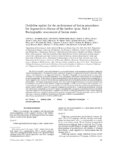 | Dailey, Andrew T. | Guideline update for the performance of fusion procedures for degenerative disease of the lumbar spine. Part 4: Radiographic assessment of fusion status | The ability to identify a successful arthrodesis is an essential element in the management of patients undergoing lumbar fusion procedures. The hypothetical gold standard of intraoperative exploration to identify, under direct observation, a solid arthrodesis is an impractical alternative. Therefore... | 2014-01-01 | |
| 143 | 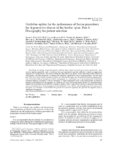 | Dailey, Andrew T. | Guideline update for the performance of fusion procedures for degenerative disease of the lumbar spine. Part 6: Discography for patient selection | Identifying the etiology of pain for patients suffering from chronic low-back pain remains problematic. Noninvasive imaging modalities, used in isolation, have not consistently provided sufficient evidence to support performance of a lumbar fusion. Provocative testing has been used as an adjunct in ... | 2014-01-01 | |
| 144 | 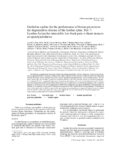 | Dailey, Andrew T. | Guideline update for the performance of fusion procedures for degenerative disease of the lumbar spine. Part 7: Lumbar fusion for intractable low-back pain without stenosis or spondylolisthesis | Establishing an appropriate treatment strategy for patients presenting with low-back pain, in the absence of stenosis or spondylolisthesis, remains a controversial subject. Inherent to this situation is often an inability to adequately identify the source of low-back pain to justify various treatmen... | 2014-01-01 | |
| 145 | 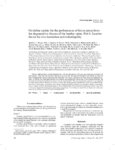 | Dailey, Andrew T. | Guideline update for the performance of fusion procedures for degenerative disease of the lumbar spine. Part 8: Lumbar fusion for disc herniation and radiculopathy | Patients suffering from a lumbar herniated disc will typically present with signs and symptoms consistent with radiculopathy. They may also have low-back pain, however, and the source of this pain is less certain, as it may be from the degenerative process that led to the herniation. The surgical al... | 2014-01-01 | |
| 146 | 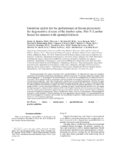 | Dailey, Andrew T. | Guideline update for the performance of fusion procedures for degenerative disease of the lumbar spine. Part 9: Lumbar fusion for stenosis with spondylolisthesis | Patients presenting with stenosis associated with a spondylolisthesis will often describe signs and symptoms consistent with neurogenic claudication, radiculopathy, and/or low-back pain. The primary objective of surgery, when deemed appropriate, is to decompress the neural elements. As a result of t... | 2014-01-01 | |
| 147 | 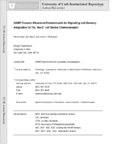 | Parkinson, John Stansfield | HAMP domain structural determinants for signalling and sensory adaptation in Tsr, the E. coli serine chemoreceptor | Motile Escherichia coli cells track chemical gradients with high sensitivity over wide concentration ranges [recently reviewed in (Hazelbauer et al., 2008; Hazelbauer & Lai, 2010)]. Stimulus detection, amplification, and integration occur in an arrayed network of signaling complexes that contain tra... | 2014-01-01 | |
| 148 | 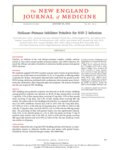 | Kriesel, John D. | Helicase-primase inhibitor pritelivir for HSV-2 infection | Background Pritelivir, an inhibitor of the viral helicase-primase complex, exhibits antiviral activity in vitro and in animal models of herpes simplex virus (HSV) infection. We tested the efficacy and safety of pritelivir in otherwise healthy persons with genital HSV-2 infection. Methods We randomly... | 2014-01-01 | |
| 149 | 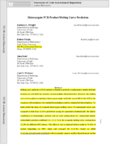 | Dwight, Zachary Lawrence | Heterozygote PCR product melting curve prediction | Melting curve prediction of PCR products is limited to perfectly complementary strands. Multiple domains are calculated by recursive nearest-neighbor thermodynamics. However, the melting curve of an amplicon containing a heterozygous single nucleotide variant (SNV) after PCR is the composite of four... | 2014-01-01 | |
| 150 | 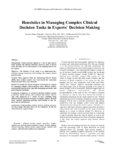 | Del Fiol, Guilherme | Heuristics in managing complex clinical decision tasks in experts decision making | Background: Clinical decision support is a tool to help experts make optimal and efficient decisions. However, little is known about the high level of abstractions in the thinking process for the experts. Objective: The objective of the study is to understand how clinicians manage complexity while... | 2014-01-01 |
